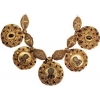|
 The jewelry
art in Russia was impressive
for the masters from ancient Europe. Yet,
today fashion designers are also captivated with ancient art of jewelry to borrow
the ancient techniques and decorations to create their own items. So, the temple
rings were transformed into earrings of larger size, and charms today come as
pendants, al the items are done using the technique of blackening, filigree and
plique-a-jour which are still exploited today. The jewelry
art in Russia was impressive
for the masters from ancient Europe. Yet,
today fashion designers are also captivated with ancient art of jewelry to borrow
the ancient techniques and decorations to create their own items. So, the temple
rings were transformed into earrings of larger size, and charms today come as
pendants, al the items are done using the technique of blackening, filigree and
plique-a-jour which are still exploited today.
The art of jewelry
in Ancient Russia was fascinating for Europeans since not only western technologies
were used by the Russians. The links with merchants from the East had also affected
the development of Russian craft work. Unlike the refined geometry figures most
likely used in the East, Russian designers mixed various techniques which
resulted in items of incredible beauty and performance.
One of the famous
tendencies is granulation technique when thousands of fine metal beads are
welded to one and the same item creating the magic play of color without using
precious metals and stones. Here, the basics of jewelry craft work was used to
make with the help of molding when the wax was used for more expensive and
limited jewels, and stone mold were used for mass production items.
Due to filigree
technique, whether superimposed or laced, the light and dynamic relief ornament
was created. Today filigree is most known in the world as one of fine craft
works and lately the bracelets done with this technique are too popular. In the
12th century, when items were made for mass production, one of the
popular techniques were engraving ad blackening onto silver, while the
background was made dark with the lighter picture and image above. The technique was skilful enough to create
elegant and refined miniatures.
In spite of
the fact that most jewelry was lost during the Mongol overlordship, the
archeologists managed to restore some unique jewelry items after. So, pairs of hollow
golden and silver pendants fastened to the headwear on chain used by the urban
beauties within 11th-13th centuries can create the
interest and concern of fashionmongers from today with the fine performance.
Especially the golden pendants decorated manually with the river pearls and
prints of the fancy birds with women hair made in the technique of the plique-a-jour.
The Grivna
of Vladimir Mononmach is known to be lost and discovered by archeologists
later. This chased medallion of the 11th century showed the lady’s
head on one side rounded by eight snakes with the pray against diseases in
Greek language, and the other side showed the archangel Michael who was
assigned to protect the jewel owner from devilish intrigues. The finest
performance of the medallion is too skilled that the jewel was estimated as the
size of Prince contribution from the average city according to scripts of that
time.
The term «jeweler»
appeared in 13th century in Russia and due to new techniques
and active use of precious stones the jewelry art was found in its bloom that
period. In the early 19th century the Russian designers elaborated
their own style different from the European standards, and almost every single
jeweler had their own features and peculiarities.
Every master
had his own style, his own unique jewelry items which were appreciated at the
court of the Russian Emperor and by the royal families of other countries. Thus,
the Easter Faberge eggs, different from egg to egg, were ordered by the Emperor
for his family, while cheaper works of the jeweler like cigarette cases were afforded
by less wealthier persons. Today Russian designers still launch unique works of
art, staying faithful to roots, and, thus, many jewelry items made in Russia are
still highly demanded at the world market.
|